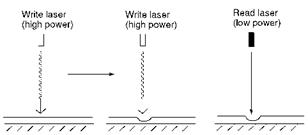In recent years there has been growing commercial interest in compounds which absorb in the near-infrared region of the electromagnetic spectrum (i. e. beyond 750 nm), a region which formerly had been regarded mainly as a scientific curiosity, rather than offering practical application significance. Interest in this region emerged particularly as a result of the development of relatively inexpensive and robust inorganic semiconductor lasers, such as the gallium-arsenic diode laser which emits around 780-830 nm, and the potential which these devices offered for the development of optoelectronic devices. Compounds which absorb at these wavelengths are commonly referred to as near-infrared absorbing dyes, even though in the strict sense they are not dyes since their absorption is outside the visible region. Nevertheless, these compounds are commonly designed and synthesised by an extension of conventional dye chemistry so that it is convenient to consider them in this context.
Optical data storage methods offer a number of advantages over conventional information storage methods, including high storage capacity and environmental friendliness. Methods have been developed which utilise the ability of near-infrared emitting inorganic lasers to write and
|
Figure 10.9 Principles of optical data storage using near-infrared absorbers |
read information. The principles of one such method, referred to as the WORM (write once read many) system, are illustrated in Figure 10.9. The optical recording media consist of discs on which a thin film of a polymer containing a near-infrared absorbing dye is deposited. When the radiation from a laser of sufficient power impacts the disc, the dye absorbs the radiation. Conversion of the absorbed radiation to heat generates a temperature which is sufficient to melt the polymer and cause the formation of a pit. The pattern formed by the pits constitutes the data. To read the information contained in the pits, the disc is scanned with a laser of lower power, insufficient to cause melting. Instead, a detector records the amount of radiation reflected from the disc, the reflectivity being lower in the data pits. The first generation compounds for optical data storage were inorganic materials, such as tellurium alloys, which were expensive and highly toxic. As a wide range of near-infrared absorbing organic dyes became available, improved performance in such applications was possible. Subsequent to these developments, the CD-R system was developed which offered the advantage over the WORM disks of compatibility with standard compact disk technology. The CD-R system uses dyes with a Ятах in the range 690-710 nm and with a small but finite absorbance in the range 780-830 nm. Optical data storage development has subsequently focused on the DVD-R system, which exploits the introduction of low cost solid state lasers operating in the 630-650 nm range and which thus utilises dyes absorbing at lower visible light wavelengths. Other applications which have emerged for near-infrared absorbing dyes include security printing, for example in banknotes and ‘invisible’ but laser-readable bar-coding for the identification of branded products, infrared photography, laser filters and appropriately designed compounds have potential for use in photodynamic therapy, a cancer treatment which is described in a later section of this chapter. Examples of near-infrared absorbing dyes include a range of phthalocyanine derivatives such as the polyarylthiophthalocyanines 235, croconium dyes such as compound 236 and nickel dithiolene complexes such as compound 237.
|
|
 13 января, 2016
13 января, 2016  Pokraskin
Pokraskin 

 Опубликовано в рубрике
Опубликовано в рубрике 